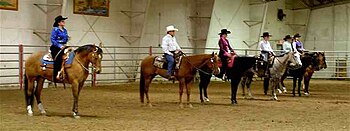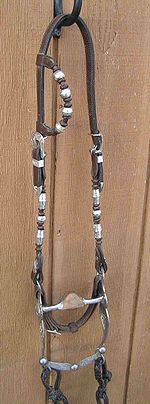
The American Saddlebred is a horse breed from the United States. This breed is referred to as the "Horse America Made". Descended from riding-type horses bred at the time of the American Revolution, the American Saddlebred includes the Narragansett Pacer, Canadian Pacer, Morgan and Thoroughbred among its ancestors. Developed into its modern type in Kentucky, it was once known as the "Kentucky Saddler" and used extensively as an officer's mount in the American Civil War. In 1891, a breed registry was formed in the United States. Throughout the 20th century, the breed's popularity continued to grow in the United States, and exports began to South Africa and Great Britain. Since the formation of the US registry, almost 250,000 American Saddlebreds have been registered and can now be found around the world, with separate breed registries established in Great Britain, Australia, continental Europe, and southern Africa.

A horse show is a judged exhibition of horses and ponies. Many different horse breeds and equestrian disciplines hold competitions worldwide, from local to the international levels. Most horse shows run from one to three days, sometimes longer for major, all-breed events or national and international championships in a given discipline or breed. Most shows consist of a series of different performances, called classes, wherein a group of horses with similar training or characteristics compete against one another for awards and, often, prize money.
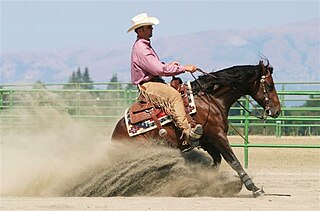
Reining is a western riding competition for horses where the riders guide the horses through a precise pattern of circles, spins, and stops. All work is done at the lope, or the gallop. Originating from working cattle, reining is often described as a Western form of dressage riding, as it requires the horse to be responsive and in tune with its rider, whose aids should not be easily seen, and judges the horse on its ability to perform a set pattern of movements. The horse should be willingly guided or controlled with little or no apparent resistance and dictated to completely. A horse that pins his ears, conveying a threat to his rider, refuses to go forward, runs sideways, bounces his rear, wrings his tail in irritation or displays an overall poor attitude is not being guided willingly, and is judged accordingly.

Equitation is the art or practice of horse riding or horsemanship.

"English pleasure" is the generic term for a number of different English riding classes seen at horse shows in the United States, where the horse is ridden in either hunt seat or saddle seat tack.

The Hackney pony is a breed of pony closely related to the Hackney horse. Originally bred to pull carriages, they are used today primarily as show ponies. The breed does not have its own stud book, but shares one with the Hackney horse in all countries that have an official Hackney Stud Book Registry.

Equine conformation evaluates a horse's bone structure, musculature, and its body proportions in relation to each other. Undesirable conformation can limit the ability to perform a specific task. Although there are several faults with universal disadvantages, a horse's conformation is usually judged by what its intended use may be. Thus "form to function" is one of the first set of traits considered in judging conformation. A horse with poor form for a Grand Prix show jumper could have excellent conformation for a World Champion cutting horse, or to be a champion draft horse. Every horse has good and bad points of its conformation and many horses excel even with conformation faults.

The Hunter division is a branch of horse show competition that is judged on the horse's performance, soundness and when indicated, conformation, suitability or manners. A "show hunter" is a horse that competes in this division.

Hunt seat is a style of forward seat riding commonly found in North American horse shows. Along with dressage, it is one of the two classic forms of English riding. The hunt seat is based on the tradition of fox hunting. Hunt seat competition in North America includes both flat and over fences for show hunters, which judge the horse's movement and form, and equitation classes, which judge the rider's ability both on the flat and over fences. The term hunt seat may also refer to any form of forward seat riding, including the kind seen in show jumping and eventing.
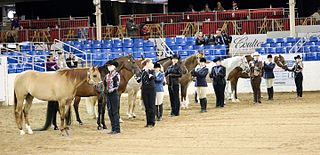
Showmanship is an event found at many horse shows. The class is also sometimes called "Fitting and Showmanship", "Showmanship In-Hand", "Showmanship at Halter" or "Halter Showmanship" It involves a person on the ground leading a horse, wearing a halter or bridle, through a series of maneuvers called a pattern. The horse itself is not judged on its conformation. Exhibitors are judged on exhibiting the animal to its best advantage, with additional scoring for the grooming and presentation of both horse and handler.
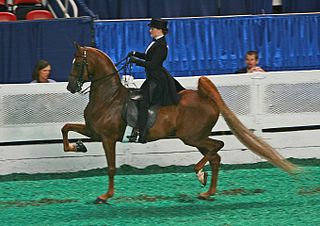
Saddle seat is a style of horse riding within the category of English riding that is designed to show off the high action of certain horse breeds. The style developed into its modern form in the United States, and is also seen in Canada and South Africa. To a much lesser extent, it is ridden with American horse breeds in Europe and Australia.
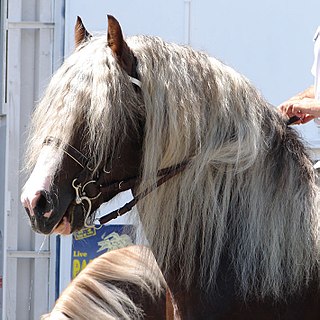
On horses, the mane is the hair that grows from the top of the neck of a horse or other equine, reaching from the poll to the withers, and includes the forelock or foretop. It is thicker and coarser than the rest of the horse's coat, and naturally grows to roughly cover the neck. Heredity plays a role, giving some horses a longer, thicker mane, and others a shorter, thinner one.

Western riding is considered a style of horse riding which has evolved from the ranching and welfare traditions which were brought to the Americas by the Spanish Conquistadors, as well as both equipment and riding style which evolved to meet the working needs of the cowboy in the American West. At the time, American cowboys had to work long hours in the saddle and often over rough terrain, sometimes having to rope a cattle using a lariat, also known as a lasso. Because of the necessity to control the horse with one hand and use a lariat with the other, western horses were trained to neck rein, that is, to change direction with light pressure of a rein against the horse's neck. Horses were also trained to exercise a certain degree of independence in using their natural instincts to follow the movements of a cow, thus a riding style developed that emphasized a deep, secure seat, and training methods encouraged a horse to be responsive on very light rein contact.
The Racking Horse is a horse breed derived from the Tennessee Walking Horse, recognized by the USDA in 1971. It is known for a distinctive singlefoot gait. In 1971, the Racking Horse Breeders' Association of America, headquartered in Decatur, Alabama, was formed as the breed registry. Its goal is to preserve the breed in a natural state with little or no artificial devices that enhance gait. The horse's tail is naturally raised without nicking or tail sets. Some classes allow special shoes that enhance action, and a relatively newer class allows the use of chains, six ounces and under as action devices. The practice of soring, illegal under the Horse Protection Act of 1970, is also seen within the Racking Horse world. Since the breed's inception, about 80,000 Racking Horses have been registered, with the largest populations located in the US states of Alabama and Tennessee.

Halter is a type of horse show class where horses are shown "in hand," meaning that they are led, not ridden, and are judged on their conformation and suitability as breeding stock. Depending on breed and geographic region, such events may be called "Halter," "In-Hand," "Breeding," "Model," or "Conformation" classes.

The show hack is a type of ridden show horse, exhibited to a standard first established in England.
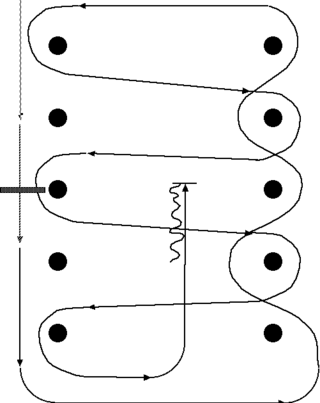
Western Riding is a competitive event at American horse shows, particularly those for stock horse breeds such as the American Quarter Horse. It is not to be confused with the general term "western riding," referring to the many forms of equestrianism where riders use a western saddle; instead, it refers to a particular class where the horse and rider complete a pattern that incorporates elements of both reining and trail classes, but requiring horses to perform in a quiet style akin to that of a Western pleasure class. Horses are evaluated on “quality of gaits, lead changes at the lope, response to the rider, manners and disposition." While all three gaits are required, most of the pattern is performed at a lope. Emphasis is placed on the horse's smoothness, even cadence, and precise, clean flying lead changes.
The Pinto Horse Association of America (PtHA) registers horses, utility horses, ponies and miniature horses of various pedigrees with certain kinds of pinto coat colors. The word pinto is Spanish for "paint." In general terms, pinto can apply to any horse marked with unpigmented pink-skinned, white-haired areas on its coat. The Pinto Horse Association of America provides the owners and riders of pintos with a show circuit and a breed organization. The primary requirement for PtHA registration is coat color; the pinto is not a true breed, but a color breed.

This is a basic glossary of equestrian terms that includes both technical terminology and jargon developed over the centuries for horses and other equidae, as well as various horse-related concepts. Where noted, some terms are used only in American English (US), only in British English (UK), or are regional to a particular part of the world, such as Australia (AU).

The tail of the horse and other equines consists of two parts, the dock and the skirt. The dock consists of the muscles and skin covering the coccygeal vertebrae. The term "skirt" refers to the long hairs that fall below the dock. On a horse, long, thick tail hairs begin to grow at the base of the tail, and grow along the top and sides of the dock. In donkeys and other members of Equus asinus, as well as some mules, the zebra and the wild Przewalski's horse, the dock has short hair at the top of the dock, with longer, coarser skirt hairs beginning to grow only toward the bottom of the dock. Hair does not grow at all on the underside of the dock.
